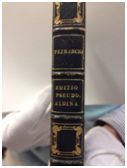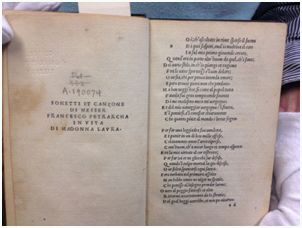It is never easy to deliver a new idea, a new invention, or a new product. In his famed article, “Is Google Making us Stupid?”[1] Nicholas Carr notes that Guttenberg’s invention was met with anxiety by many, who worried that “cheaply printed books would undermine religious authority, demean the work of scholars and scribes, and spread sedition and debauchery.” The second point was specifically addressed by one of the greatest printers of the Renaissance, Aldo Manuzio [Aldus Manutius] (1449-1515), when he produced his 1501 edition of Petrarch’s delicate poems in Italian.
Cornell copy Petrarch PQ4476 B01 [ill. 1], printed on vellum, and using italics, is an exquisite object, but it also provides us with a great example of what Ben McCorkle has called “the rhetorical delivery as technological discourse.”[2]
This book used to be part of the great library of Spencer, Charles, 3rdEarl of Sunderland (1674-1722), a statesman, landlord, bibliophile, and distant ancestor of the late Lady Diana (Spencer). His books show his arms, with the motto, Dieu defend le droit [ill. 2]. After his death, the Earl’s library was divided between two branches of the family, with one portion going to Althorp, Northamptonshire,[3] and one (including the 1501 Petrarch) to Blenheim [ill. 3], a larger version of Downton Abbey located in Oxfordshire. The library at Blenheim was increased by the Dukes of Marlborough, and a catalogue was printed in 1872. Between 1881 and 1883, the collection was dispersed by London-based dealer Bernard Quaritch, only a few years after Winston Churchill was born in the palace.[4] The collection was particularly strong in incunabula — many of them printed on vellum for limited deluxe editions. To be exact, the present volume is a post- incunable, that is, a book printed between 1501 and about 1530. It was acquired in November 1882 by Willard Fiske [ill. 4], the first Cornell University Librarian, who began to assemble a Petrarch Collection in the spring of 1881.[5]
The colophon [ill. 5] says that the book was printed in Venice in the house of Aldo Romano[6] in July 1501, with a text based on authenticated 14th century manuscripts left by Petrarch himself (dallo scritto di mano medesima del Poeta), and edited by Pietro Bembo who “held them” at some point (havuto da messer Piero Bembo, nobile Veneziano, et dallui, dove bisogno, e stato riveduto et racconosciuto).[7] There is no trace of the famous dolphin wrapped around an anchor, because this commercial device appeared later, in the second state of the 1502 edition of Dante’s Terze Rime.
According to McCorkle, the printing revolution was accomplished “by emulating the forms of manuscripts […]. The ascendency of print technology was a steady transformation that made use of [the] twin logics of mediacy and hypermediacy, a relatively slow dance of remediation that owed at least as much to handwritten and spoken discourse for its existence as it did to its own technological novelty.” Our transition book may still bear some resemblance with manuscript on parchment – but the text is no longer enveloped with scholarly gloss, margins now serve an aesthetic purpose (rather than annotations), poetry can be enjoyed as a refined intellectual leisure. More importantly, Manutius also argued and proved that his elegantly printed books were less flawed than copies made manually by scribes (or sold by unscrupulous printers). As a student, and then as a humanist, Aldus himself had suffered from the mediocrity of most editions of the Greek and Roman authors: he worked tirelessly to change that.[8]
At the end of this edition, Manuzio addresses the readers in a familiar and witty manner: “ALDO, A GLI LETTORI”. He begins by reaffirming that the best manuscripts were secured for this deluxe edition: Io mi credea per certo havere a bastanza dato fede della correttione di questo libro che io vi porgo, o lettori, havendovi una volta detto, che egli è tolto dallo scritto di mano medesima del Poeta, havuto da Messer Piero Bembo. Despite his young age (he was thirty-one), Piero Bembo [ill. 6] was already a renowned philologist and linguist. He would establish the modern literary canon with Dante, Petrarch, and Boccaccio as the three most important Italian writers. In the words of William Kennedy, Bembo both “authorized” and “petrified” Petrarch.[9] In short, the fact that he certified and edited the manuscripts for this edition is an assurance of quality and reliability.
Thus, the only errors in the book are “extra-textual”, fuori del testo. Indeed, our edition also contains a complete list of “errors made during the printing process” (errori, che stampando si sono fatti). Bembo could not be blamed for any mistake in the transcriptions, editing, and revisions.
Finally, Aldo bids the readers “farewell”, and proudly announces that another and similarly excellent book, is coming soon from the Aldine Press: State sani, et aspettate in brieve un Dante non men corretto che sia il Petrarcha! There is a remarkable branding and marketing effort to gain and retain customers, not least by creating a trustful, almost friendly relationship between the printer/publisher and the reader.
Clearly, Aldus Manutius had set new standards for printing and publishing, and readers were appreciative: more than a thousand copies of the Aldine Petrarch book were printed and sold, most of them on paper (at the time, the average output was 300 to 400 copies). The downside of success was that several imitations or pirate editions appeared on the book market, for instance in Lyon, France (Cornell, Petrarch Tiny PQ4476 B03 1503, on paper) [ills. 7 and 8]. Joanna Kostylo has described the resulting legal fights, with their mixed results, even though Manutius emerged as probably “one of the best protected publishers of his time”.[10]
[1] The Atlantic Monthly Magazine, June 2008.
[2] The excellent book with this title was released by Southern Illinois University Press in 2012.
[3] Lady Diana came from the Althorp branch.
[5] Patrick J. Stevens, “The Passionate Collector: Willard Fiske”, online catalog for the 2005 exhibition at Cornell University Library. http://rmc.library.cornell.edu/collector/petrarch/index.html
[6] Aldus was born in Bassiano Romano, about sixty kilometers southeast of Rome.
[7] The great scholar Nino Quarta found the phrasing “equivocal”. Most likely, Aldus Manutius owned the Petrarch manuscript and he lent it to Bembo, for the 1501 editions on paper and vellum (unless he just facilitated the loan?). Bembo, who apparently had started his work without the manuscripts in Petrarch’s hand for the Aldine edition, was eventually able to buy them for himself much later, in 1544: “Che intese di dire con queste parole? C’egli avea avuto lui in prestito, et l’avea riveduto e racconosciuto ecc. per la sua stampa? Il Bembo non aveva il codice originale, quando comincio la sua copia; l’ebbe prima di finirla, se ne servi, ma dovette poi naturalmente restuirlo al padrone… che l’avea molto caro. Solo molti anni dopo, nel 1544, quel codice, per compra, divenne cosa sua. L’espressione usata da Aldo e equivoca. ” Studi sul Testo delle Rime del Petrarca, Naples, 1887, p. 36.
[8] Lucien Febvre and Henri-Jean Martin, The Coming of the Book: The Impact of Printing, 1450-1800, trans. David Gerard, London: N.L.B., 1976.
[10] Joanna Kostylo, “1503: Aldus Manutius’s Warning against the Printers of Lyon”, http://copy.law.cam.ac.uk/cam/tools/request/showRecord?id=commentary_i_1503. The manuscript of Manuzio’s petition against counterfeiters is kept in the Venetian State Archive, ASV, Senato Terra, reg. 14, c. 112r.








{ 4 comments… read them below or add one }
Aldus Manutius is credited as the inventor of the modern semicolon. Did he make use of it in this 1501 edition of Petrarch?
Yes. The semicolon is actually the first punctuation sign to appear in the book:
Oi; ch’ascolte […]
Quand’era in parte altr’huom da quel, ch’i sono; etc.
Laurent.
Thank you for this lovely, informative essay.
It is my pleasure to welcome Laurent Ferri, Curator, pre-1800 Collections Division of Rare Books and Manuscripts, Kroch Library (Cornell), to Rare Book Digest.